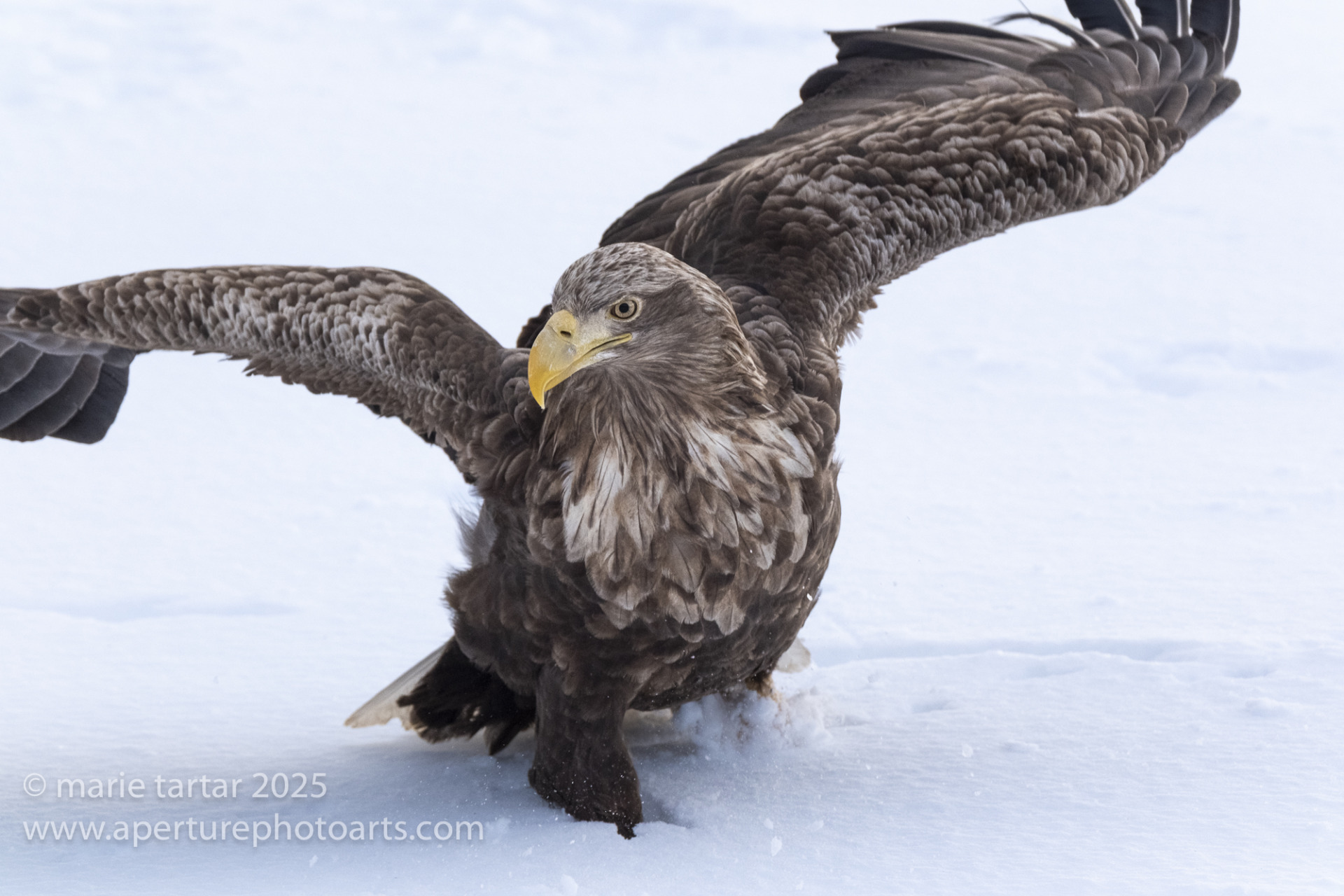
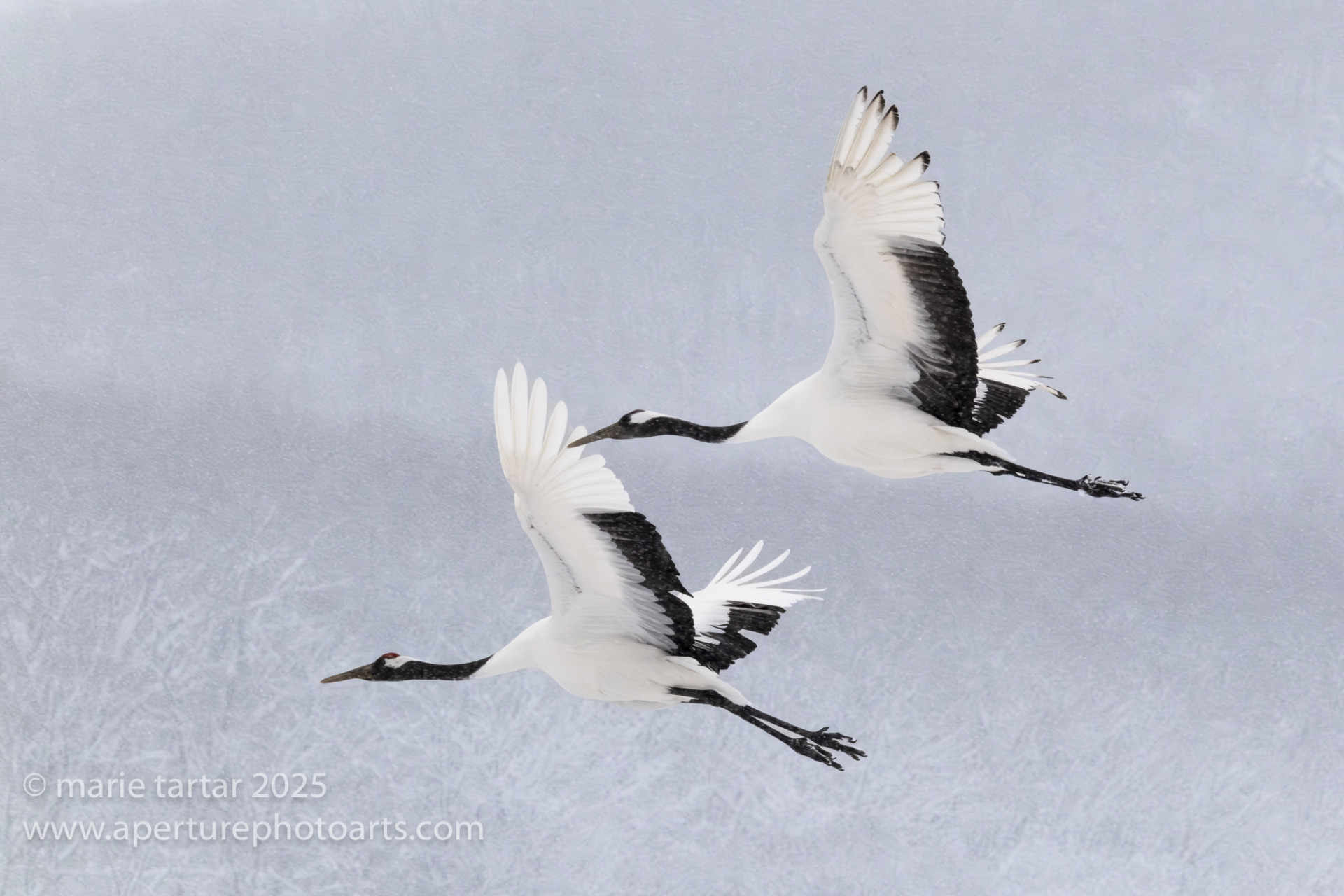
Time to bid the red-crowned cranes adieu-we were off in search of other Hokkaido wildlife, namely, sea eagles, foxes and deer on the Shiretoko peninsula.
After four fabulous days photographing red-crowned cranes and whooper swans, we were heading further north to the Shiretoko Peninsula, where we would devote three consecutive cold mornings to boat outings to photograph sea eagles.
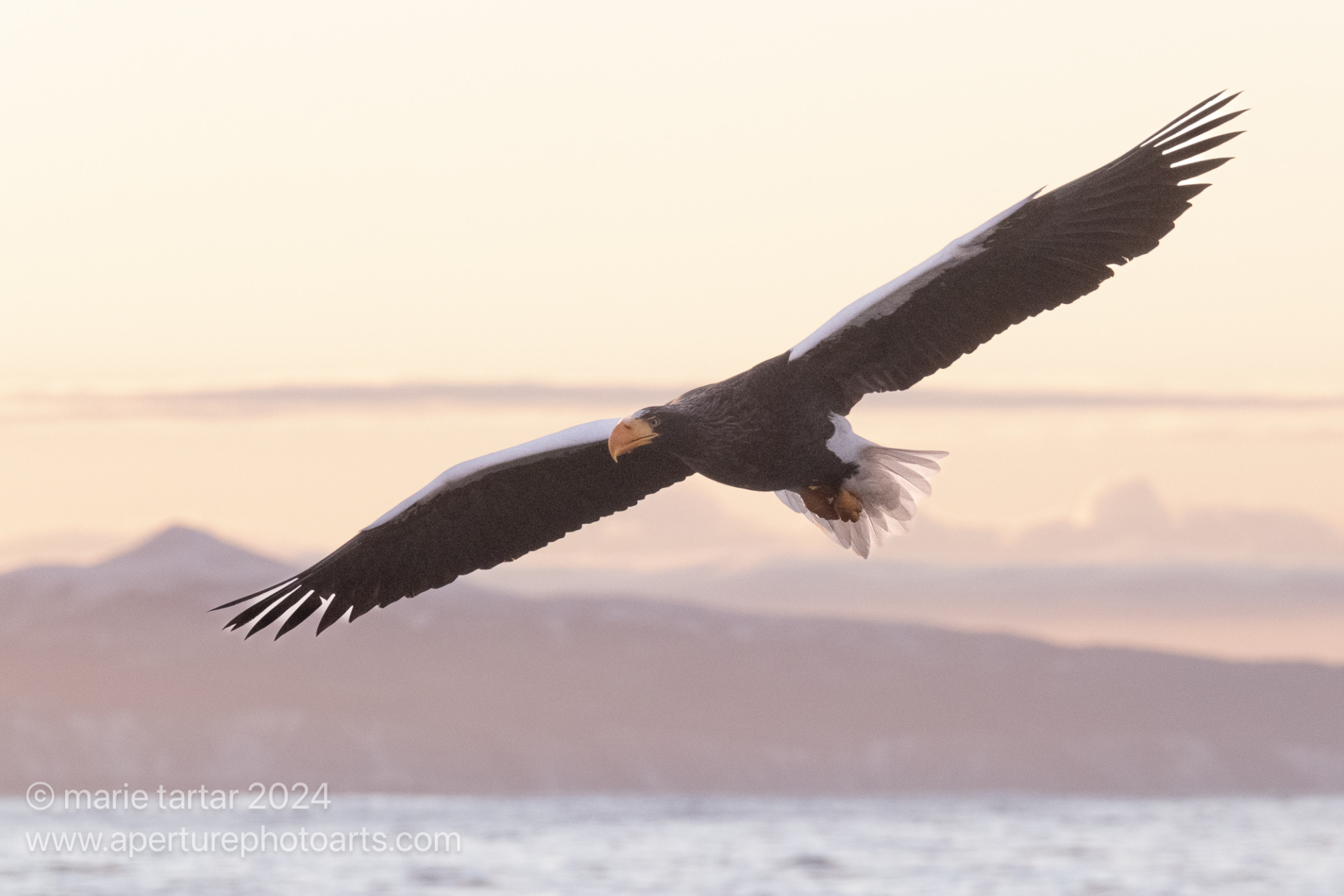
Soaring Steller’s sea eagle (Haliaeetus pelagicus) is named after the German-born naturalist and explorer, Georg Wilhelm Steller, who accompanied Bering’s Great Northern Expedition (1733-1743) to the then-uncharted waters between Siberia and North America. Steller’s sea eagle is the heaviest of the eagles. It is considered on the IUCN Red List as a vulnerable species (International Union for Conservation of Nature).
Wednesday, February 5, 2025
After a final hour back at Swan Lake (Lake Kussharo), where mist was rising through the distant hills encircling the lake and sun was warming the whopper swans, we were on our way to Rausu via an afternoon on the Notsuke Peninsula, in search of fox and deer. We didn’t have long to wait. The bus windows (except the furthest fore and aft) could be opened, allowing us to poke our long lenses out without excessively disturbing the wildlife. The deer were plentiful, on both sides of the road, males resplendent with imposing racks.
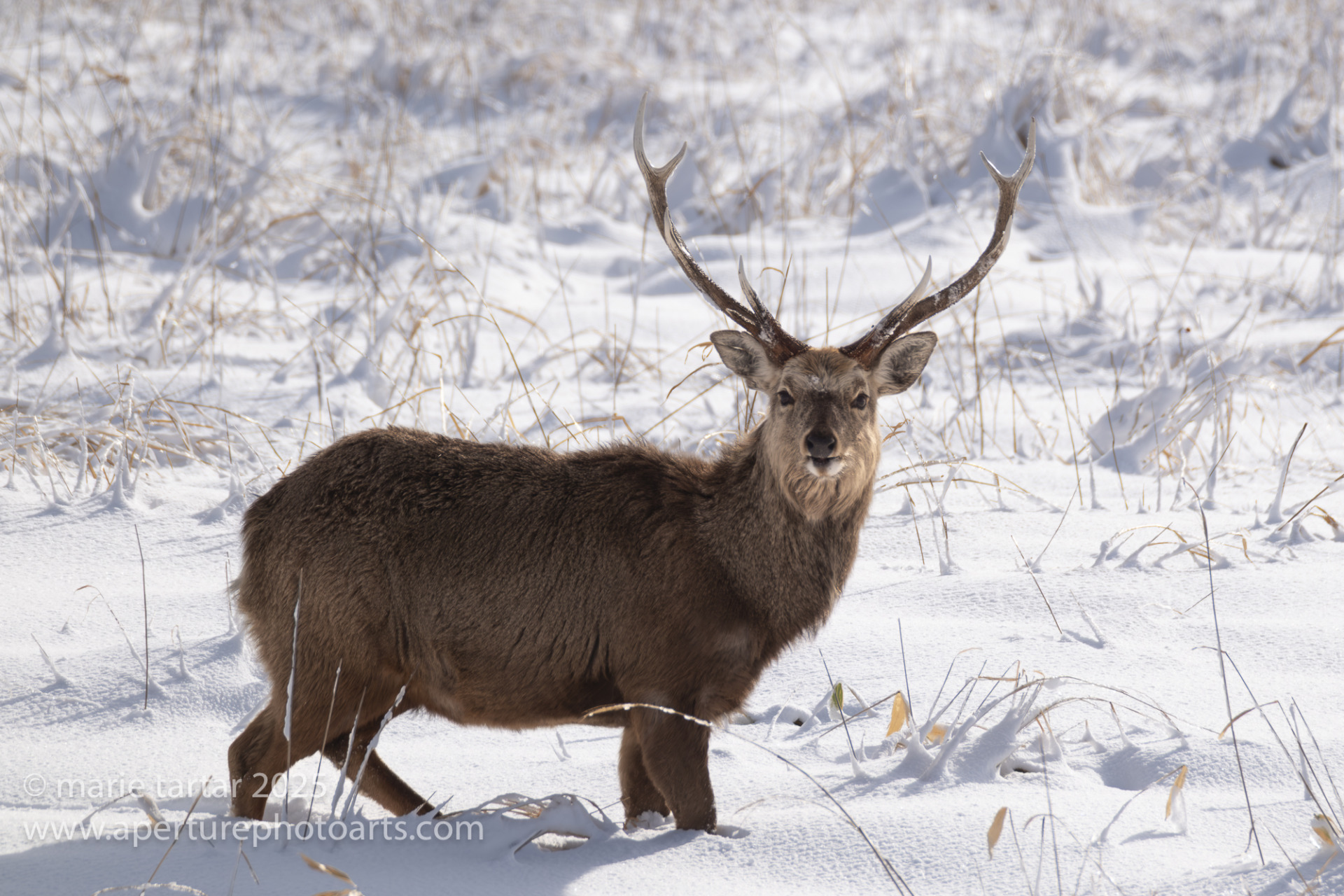
Yezo sika deer (aka Ezo shika deer or Hokkaido deer) nearly went extinct but have rebounded enough that deer-related car accidents tripled in Hokkaido between 2016 and 2023.
We did find a single fox, its coat a lovely golden red, a nice contrast with the snow.
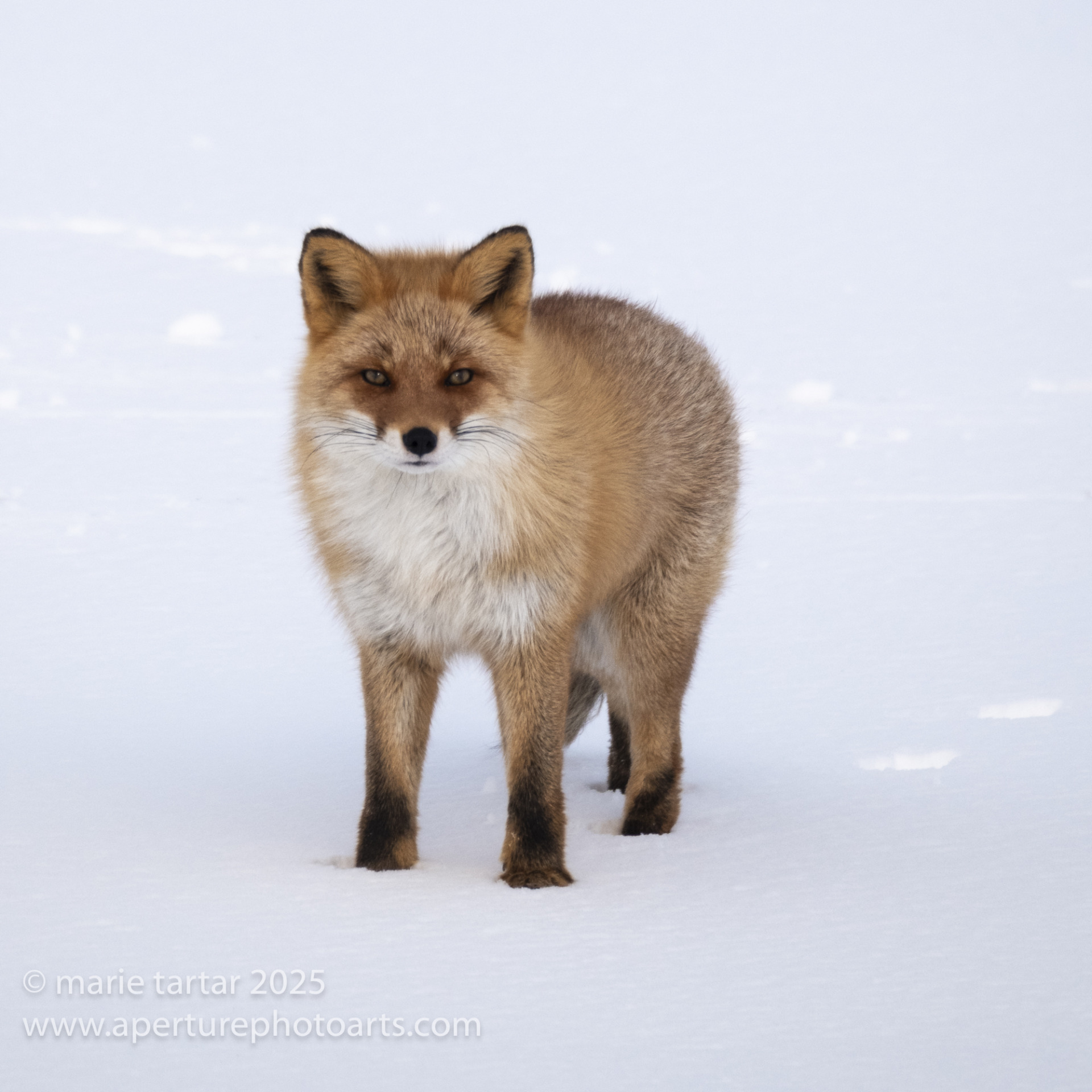
Although this Ezo red fox (Vulpes vulpes schrencki) was roundly derided as not a handsome specimen because of its threadbare tail, I found its face quite appealing and in this pose, his tail is hidden.
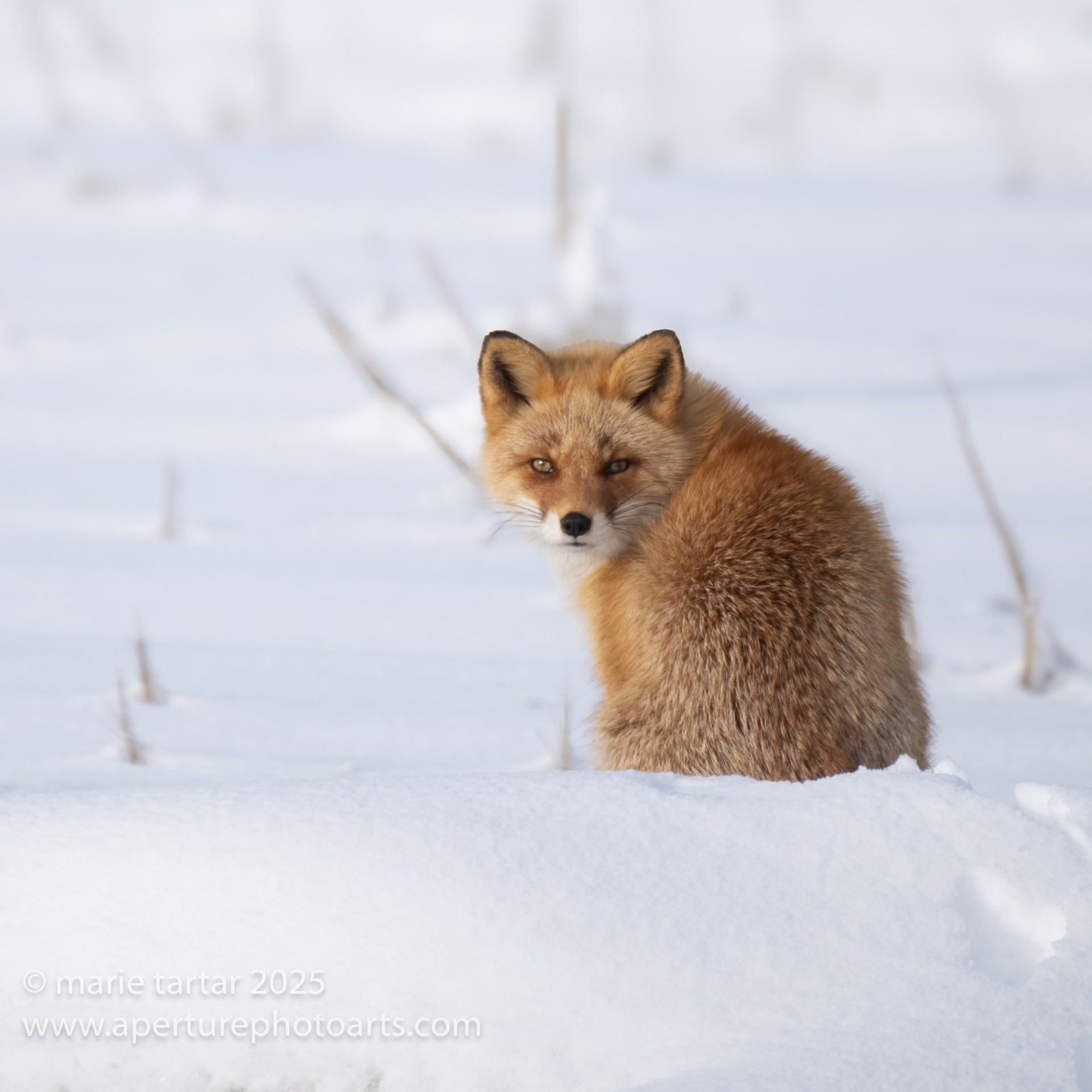
Another effective spindly tail-hiding pose by our Ezo red fox in snow on the Notsuke Peninsula, Hokkaido, Japan.
Dinner at the hotel was a multi-course affair, including half a crab with spindly, difficult-to-dissect legs.
Thursday, February 6, 2025
The alarm went off at 4:45 am, necessary for loading onto the bus at 5:30 am. It was but a 15-minute ride to the harbor, well-timed for our 6 am boat departure.
Our group commandeered the right side of the boat, lined up along the frosty rail. Departing in the dark let us warm up by shooting silhouettes of the sea eagles as the sky gradually lightened. Numerous birds circled overhead, but it is the fish tossed overboard at regular intervals that brings the birds in close enough for satisfying photography.
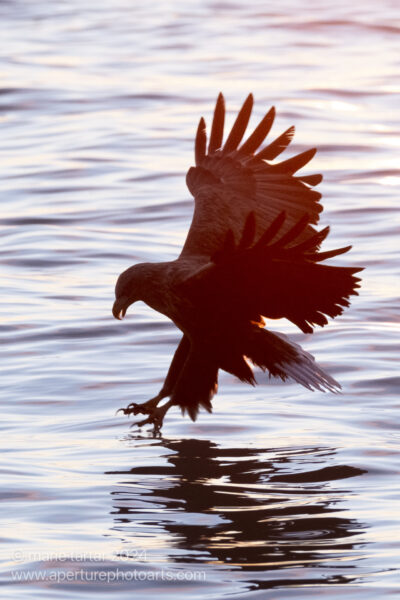
Touch down! White-tailed sea eagle, talons extended, grazes the water’s surface, while locked in on an easy meal-a fish tossed from our boat. (Rausu, Hokkaido, Japan)
Two other boats were also out. Following the soaring missiles seemed more difficult than I remembered from our 2018 trip, when I pre-focused on the patch of water where a fish was tossed and tracked the incoming birds approaching parallel to the boat.
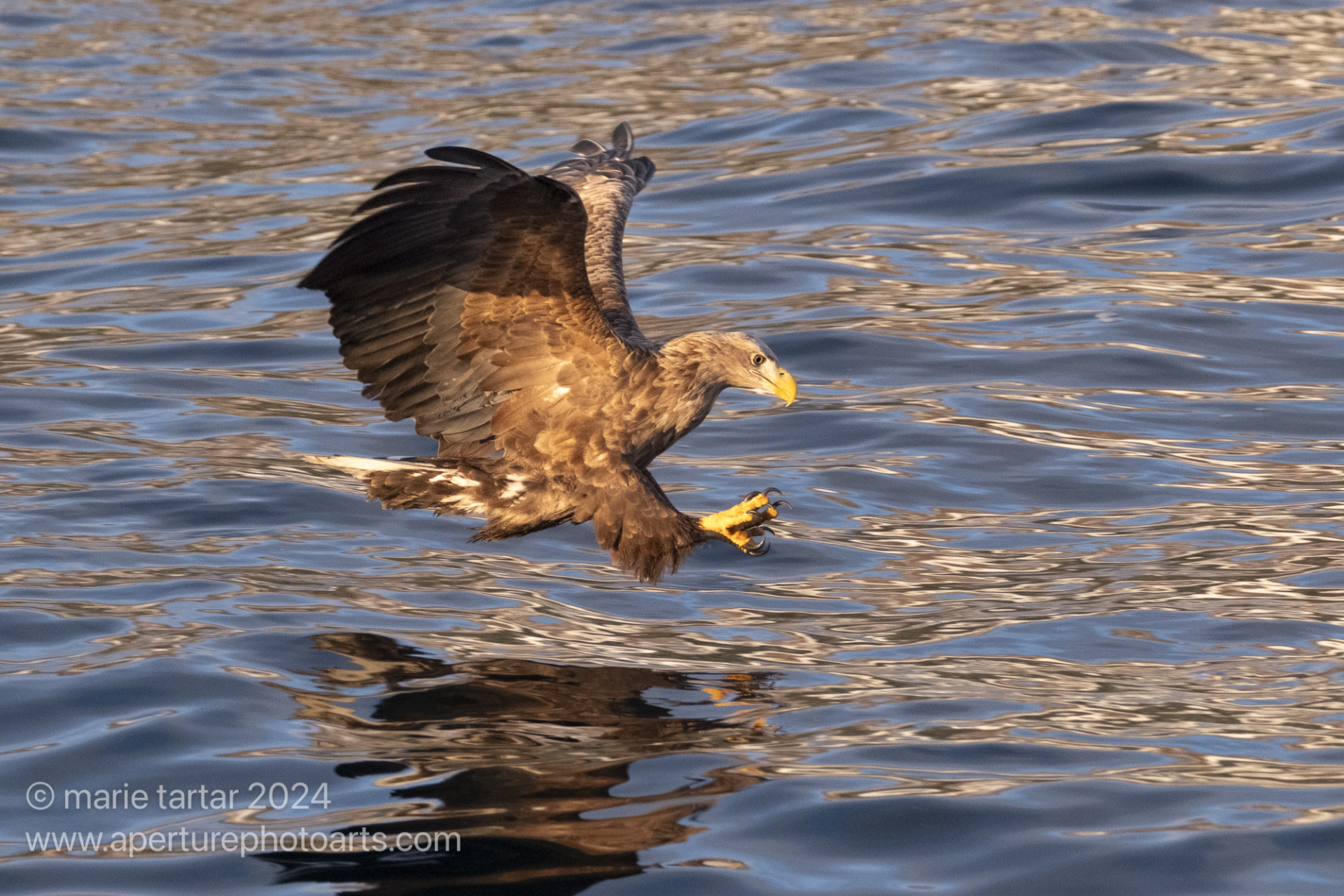
The sea eagles lock onto their fish targets with lazer-like focs, rarely missing their objectives. White-tailed eagle, Rausu, Hokkaido, Japan. The white-tailed eagle (Haliaeetus albicilla) has a wide range, from Greenland east to Hokkaido. Although this species has been considered endangered in the past, today it is considered of Least Concern by IUCN.
This time, it seemed like more eagles dive-bombed from above, making it harder to anticipate their trajectories.
We finished by pausing by a snow-covered jetty, forming part of the break-water, where the eagles seemed to be huddled, resting. Even there, fly-outs and ins and confrontations enlivened the more static portraiture session.
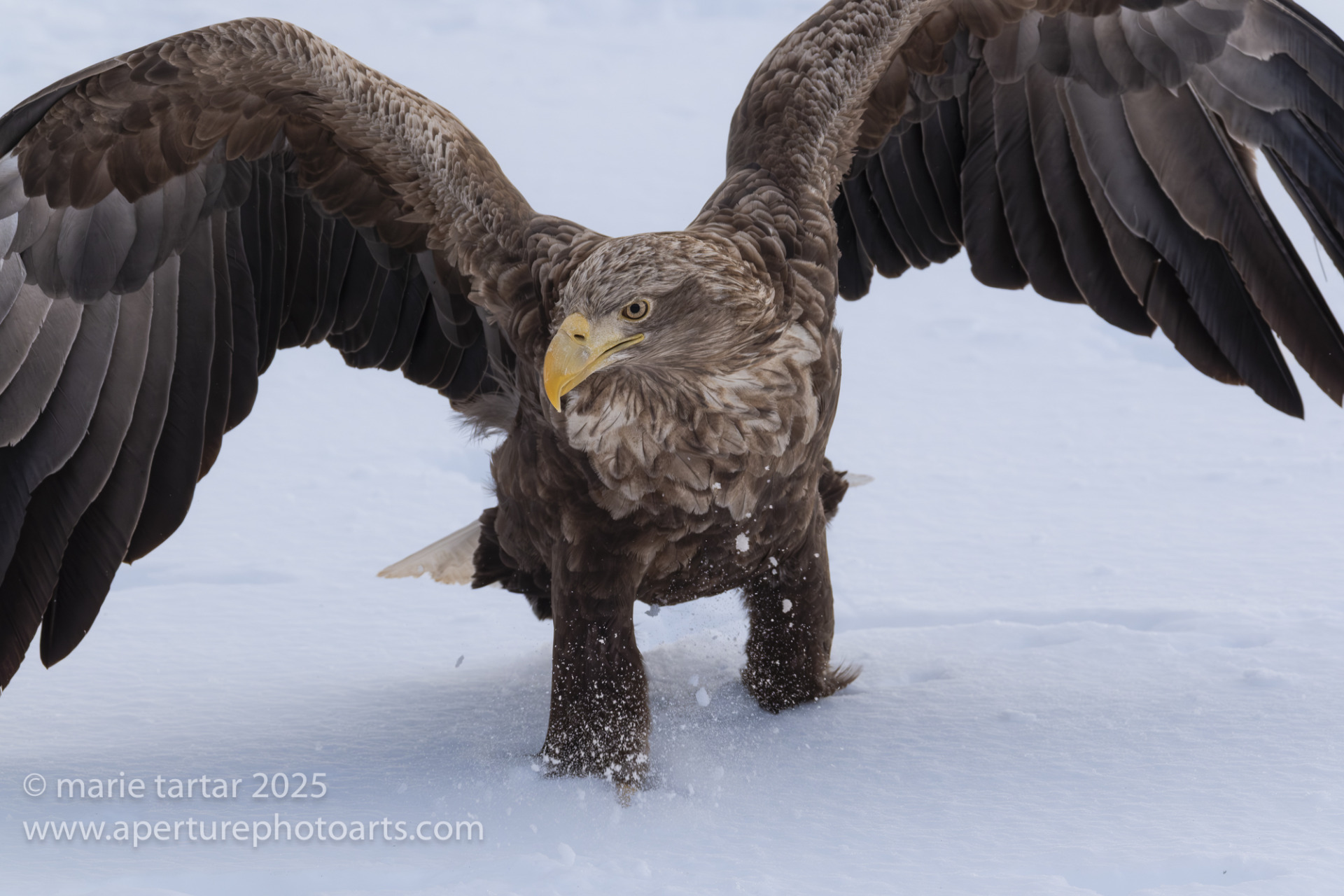
What a magnificent creature! This is probably my favorite of my sea eagle shots (white-tailed sea eagle, Rausu, Hokkaido, Japan).
After breakfast at the hotel, we had time to warm up and download to assess the morning’s results. We headed back out at 11:30 am, back to the harbor, in search of harlequin ducks. They proved to be elusive and scarce. Sea ice was now sloshing around in the colorful harbor.
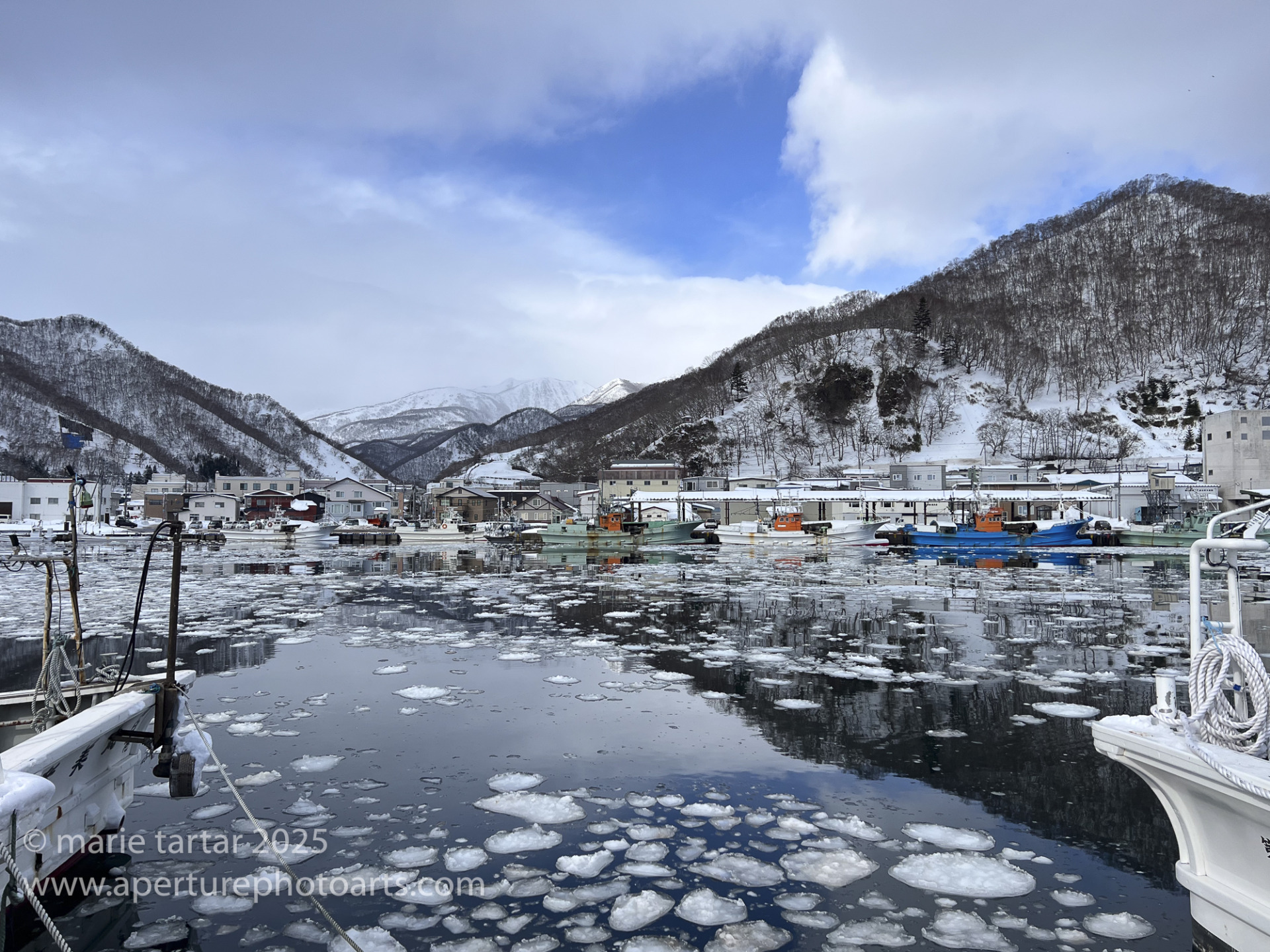
Sea ice in the colorful harbor at Rausu, Hokkaido, Japan. We keep hoping for sea eagles on sea ice, but struck out again.
Dinner this evening included a different variety of crab, this one with spiny legs, which yielded more meat after some adroit wielding of the scissors.
Friday, February 7, 2025
Another early morning, dressing in the dark, to make it onto the bus for the short ride to the harbor and the boat for another round of sea eagle photography. This morning I ended up in the middle of our troop, aligned along the starboard side of the boat, next to Martin. While it was still dark, Martin suggested adjusting parameters to pan along with the hurtling dark silhouettes of the birds. They spin and wheel around, sometimes reversing course, constantly keeping us guessing which one will swoop out of the sky to pluck a fish from the sea.
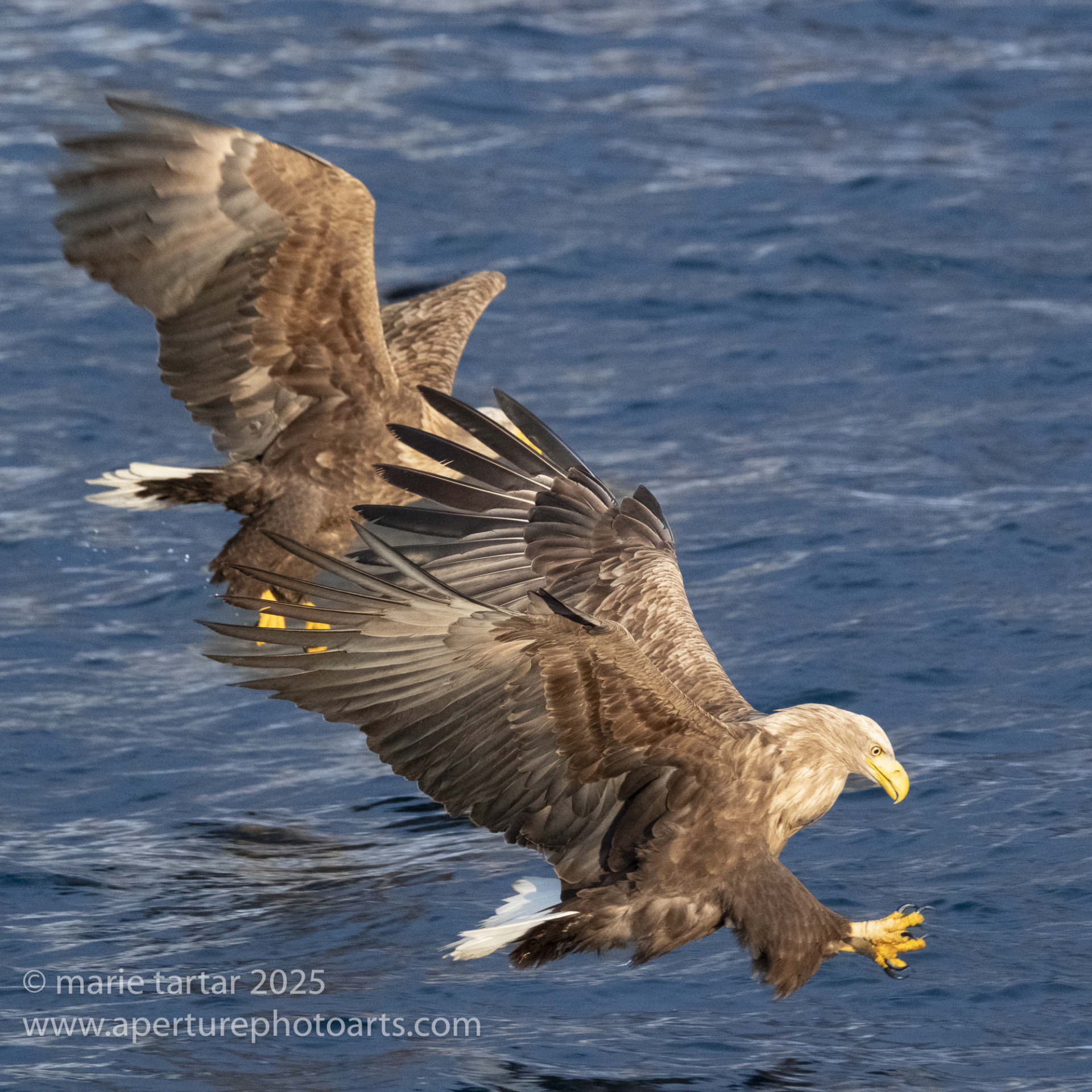
A pair of white-tailed eagles race to scoop up a tossed fish from the sea, near Rausu, Hokkaido, Japan.
A small cohort of us (me, Greg, Gail, Benito and Deji, accompanied by Yukiko) elected to follow up the morning shoot with a blessing at the Shinto shrine.
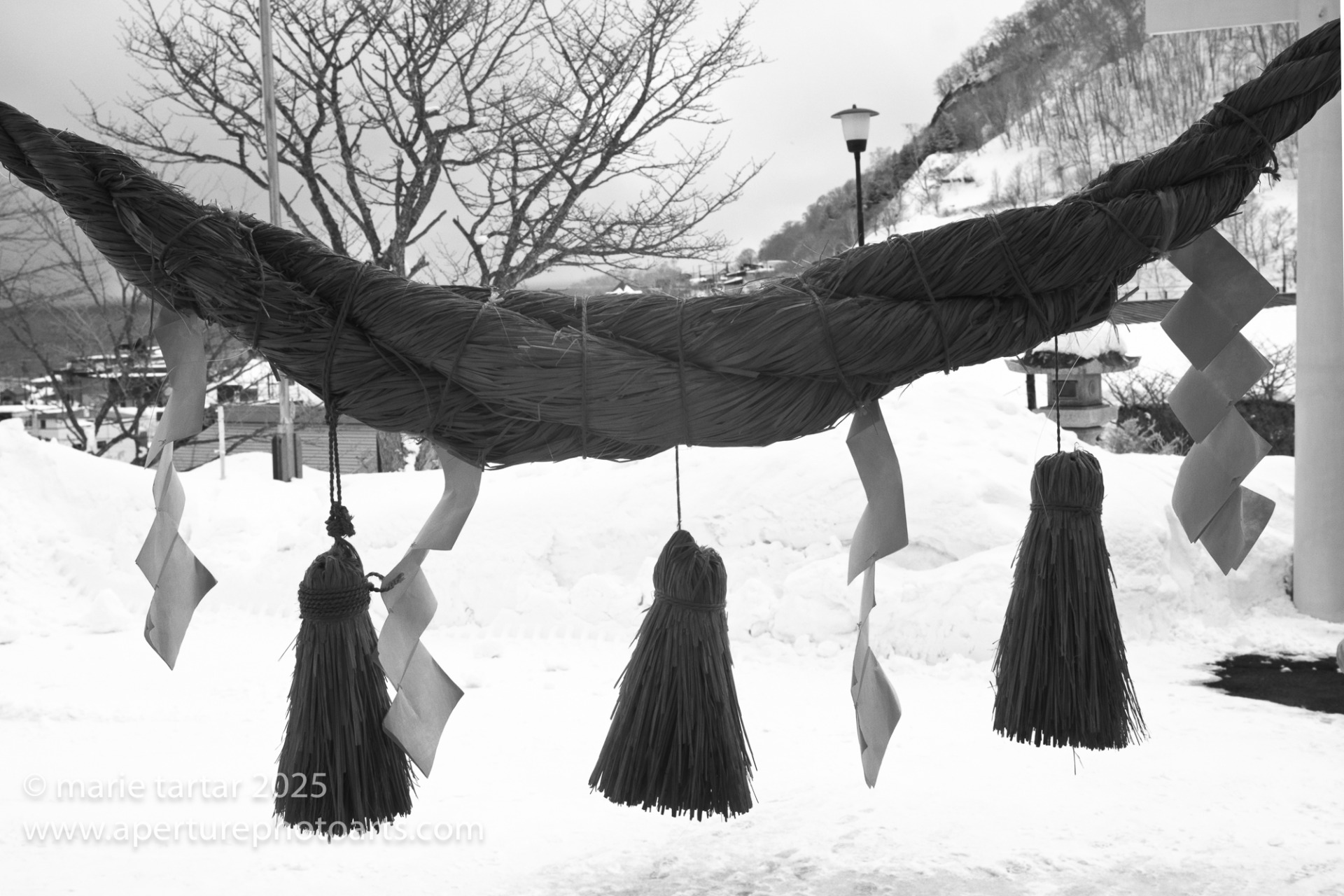
Shinto shrine, Rausu, Hokkaido, Japan (IR). Woven straw ropes (shimenawa) mark the boundaries of a sacred space. Shintoism is a polytheistic animistic religion, worshiping nature or nature spirits (a practice I can get behind). The lightning -shaped shide are made of paper. Two theories exist as to the significance of this shape, one invoking the power of the gods and the other an appeal for a good harvest (lightning being linked to rain).
The local priest has been there for 40 years. We weren’t allowed to photograph inside the shrine, which featured gold medallions with a stylized kelp plant, unique to this shrine. We were instructed to offer a leaf branch to the goddess, bow twice, clap twice (to attract the spirits), pray, then bow again (once). I’m not usually prone to inappropriately timed giggles, but could hardly contain them when Greg got the moves hopelessly out of sequence.
In the afternoon, after picking up the rest of the group, we foraged for lunch at 7-11 (marveling at the individual smoothie machine, which Sara knew about from Instagram) and retraced our trajectory down the peninsula, keeping our eyes peeled for wildlife. Deer were plentiful and foxes were spotted as well, including Mr. Skimpy Tail from our prior foray.
King crab legs were the featured crustacean of the evening meal.
Saturday, February 8, 2025
Our third and final early morning sea eagle outing was enhanced by a spectacular sunrise. A gray shroud rolled in as we disembarked and it started snowing again.
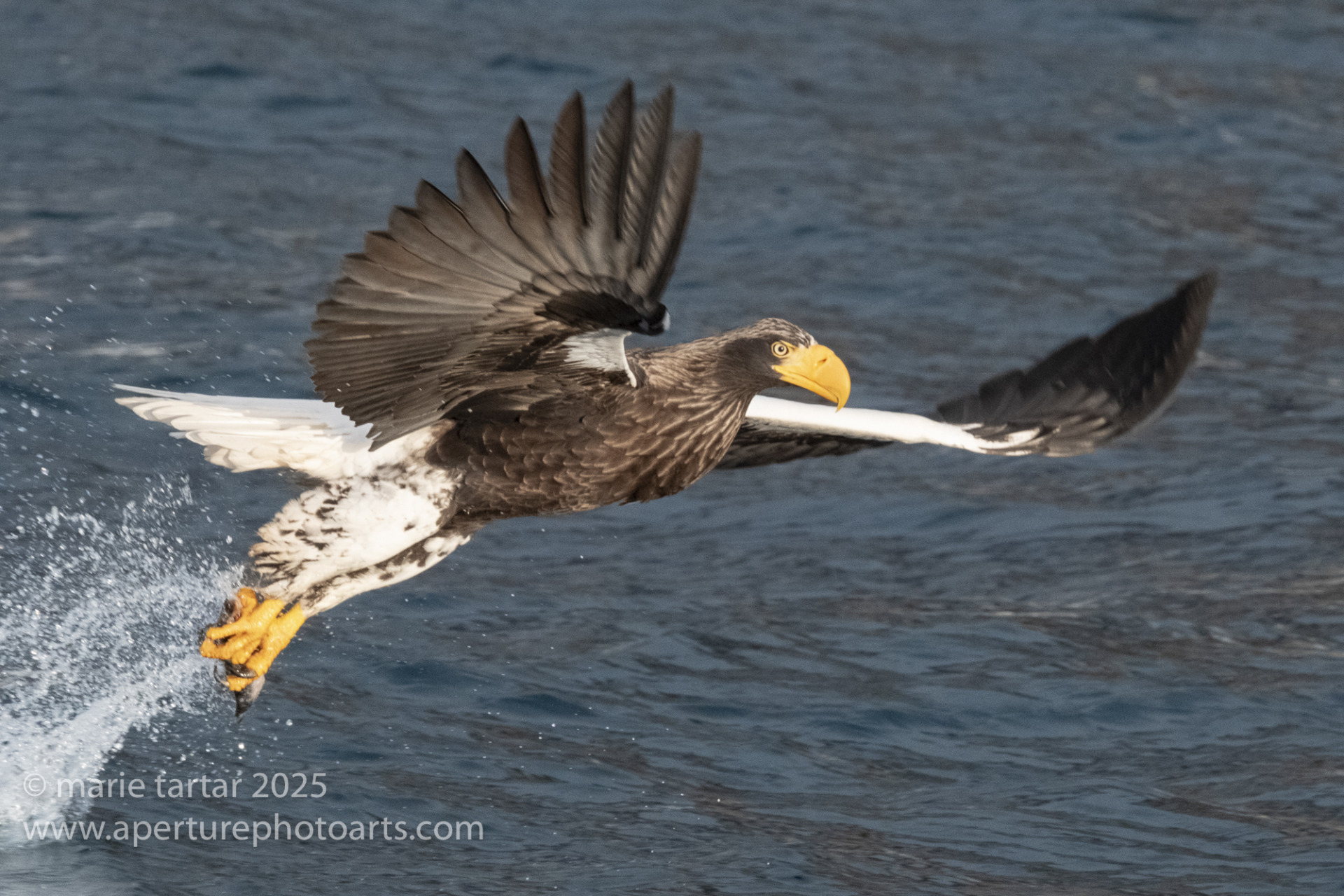
Steller’s sea eagle, fish catch clutched in its talons, makes a hasty get-away, near Rausu harbor, Hokkaido, Japan.
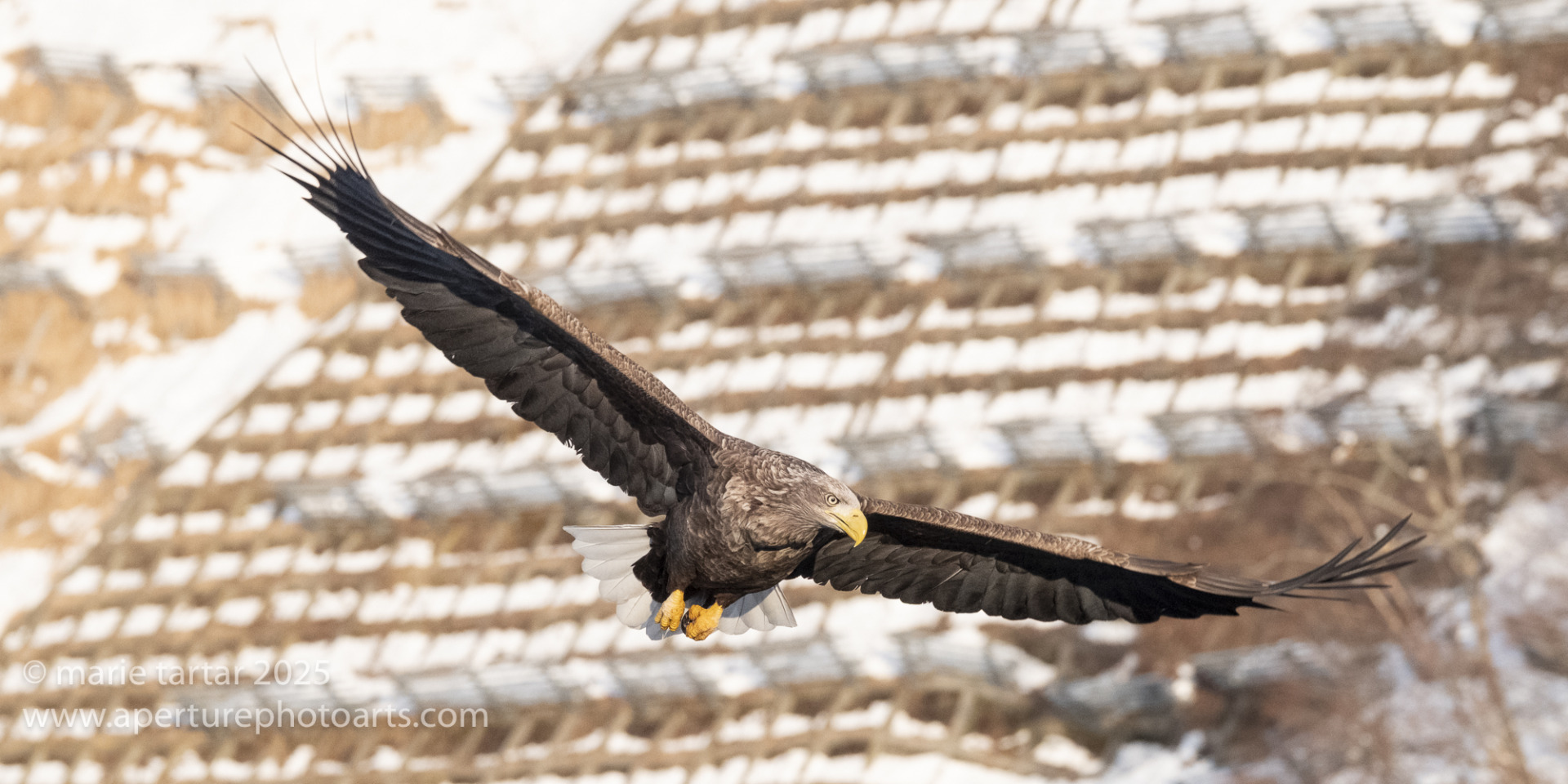
The snowy seawall of Rausu (Hokkaido, Japan) makes an interesting complementary backdrop for a soaring white-tail eagle.
Afterwards, we had to pack up and load into the bus to head to the other side of the peninsula, to position ourselves closer to the Memanbetsu airport from which we’d head back to Tokyo’s Haneda airport the following day.
Our journey to the opposite side of the peninsula required us to head to its base, as the more direct, mountain pass alternative route is closed in winter. As it was, our skillful driver, Sato-san, had plenty of challenging driving, with narrow, snowy and icy roads.
We warmed up over a wonderfully tasty lunch stop, featuring a local specialty, a cabbage and salmon stir-fry.
Our photographic outings included a roadside stand of birch trees, where Martin demonstrated an intentional camera movement technique, using a slow shutter speed.
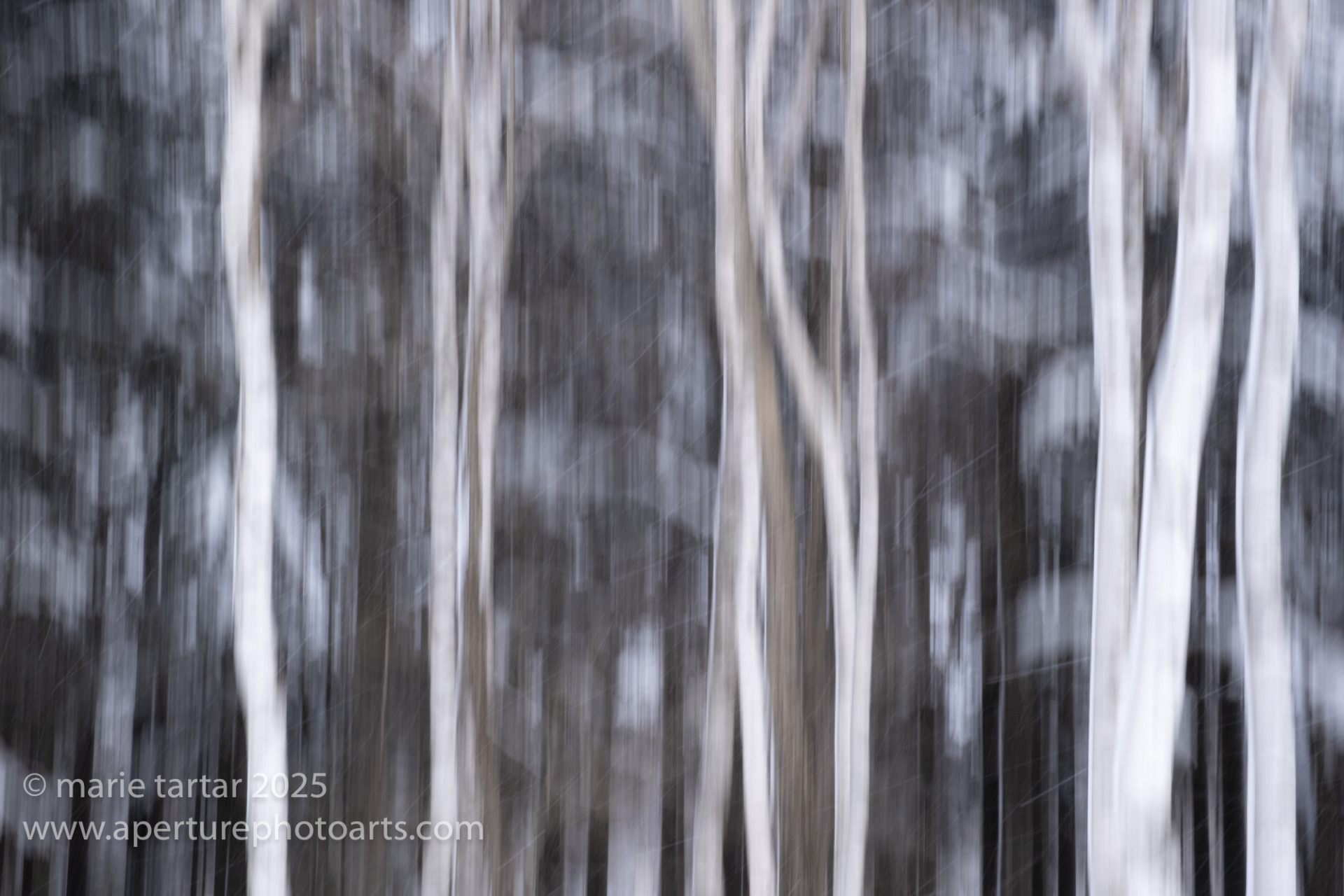
I rather like this very painterly impression of a birch forest resulting from intentional camera blur (Shiretoko Peninsula, Hokkaido, Japan).
Greg further refined this by suggesting davening (Yiddish for pray), bobbing up and down like a drinking bird toy, while holding down the shutter button.
Just before arriving at the huge Daiichi hotel complex in Shiretoko, we stopped at the Oshinkoshin waterfall. It was challenging photography, very cold with intense wind, a monochromatic black and white scene.
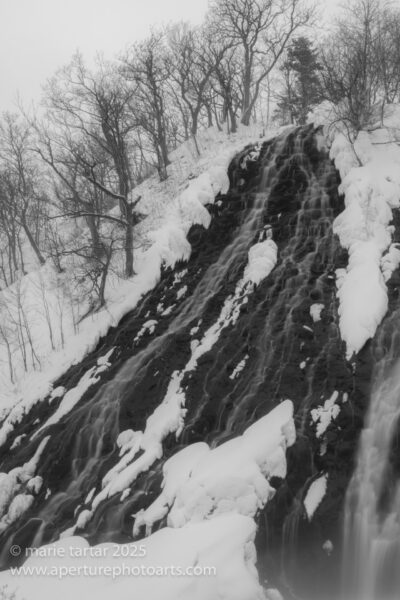
Oshinkoshin waterfall was a challenge to photograph, at least on the day we visited: cold and snowy, with near-gale force winds!
Steve continued his tradition of being injured on the penultimate day of a trip by not wearing crampons, slipping and falling on the ice, injuring his ulnar wrist.
The hotel is spacious, with abundant marble trim and custom floral rugs, known for its enormous onsen and capacious buffet, at which Sara and Sato-san presented each of us with small mementos. I capped off my Japan stay with an excellent shiatsu massage which worked out the kinks between my scapulae, followed by a soak in one of the hotel’s many pools.
Sunday, February 9, 2025
At the end of our long travel day back from Hokkaido, back at Haneda, Steve and I were positioned to continue our around-the-world travels, flying out the same evening to London, where we’d overnight, join up with Greg and continue on to Iceland for another week, hoping for auroras, frozen waterfalls and ice caves. Most of our group were dispersing to their respective homes, except for Robin, who was decompressing in Dubai and Angela and Lloyd, who were picking up a rental car and continuing their explorations of Japan. In line at security, I sighted a familiar face from home- Keiko from the Photographer’s Eye Collective, the gallery where we had our joint show in November. Crazy small world!
Our world was further enlarged by traveling with such a nice group of amiable and like-minded photographers on an exceptionally well-organized survey of Japan’s winter wildlife wonders.
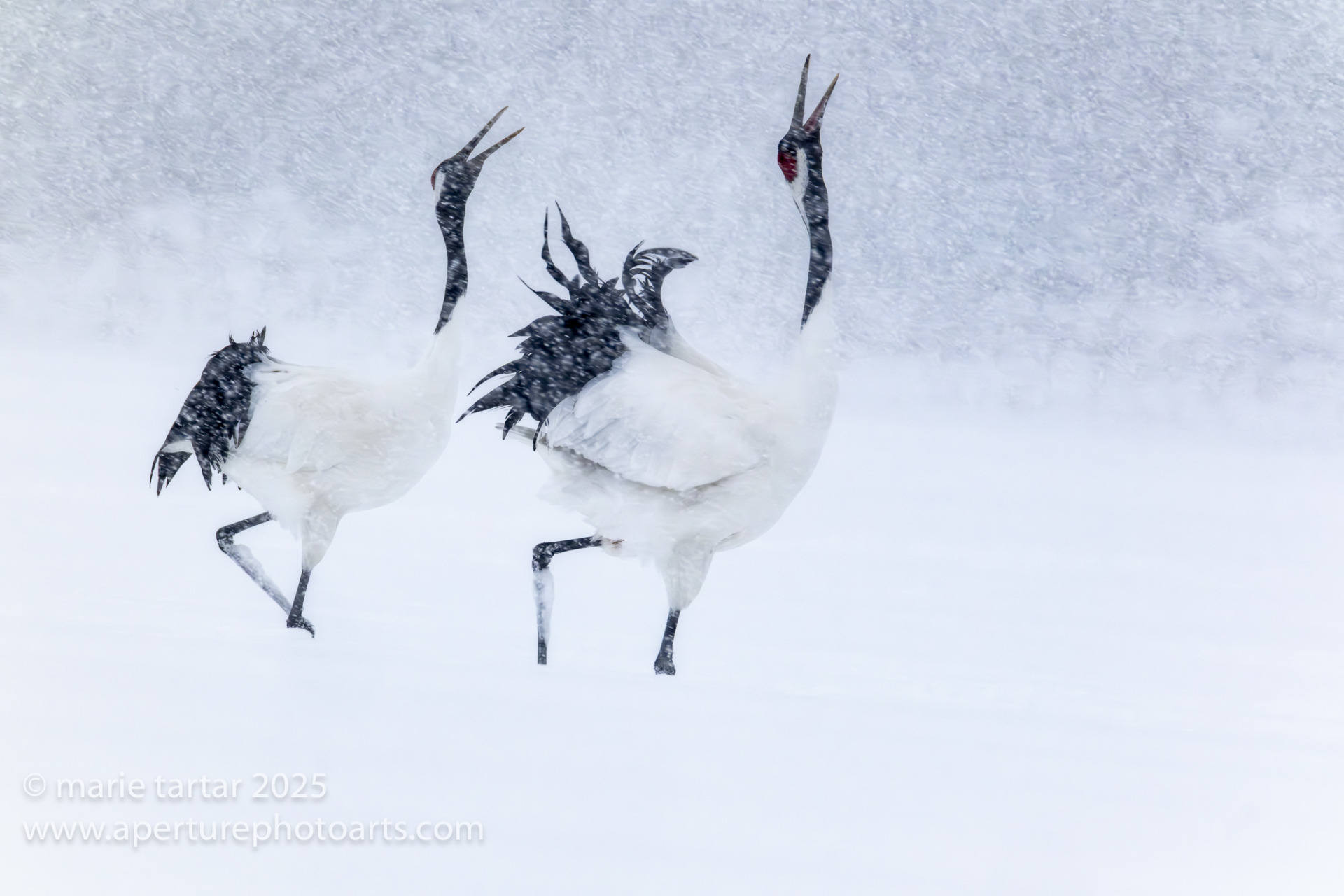
Red-crowned cranes calling in heavy snowfall, Hokkaido, Japan; hard to take leave of such a beautiful scene.
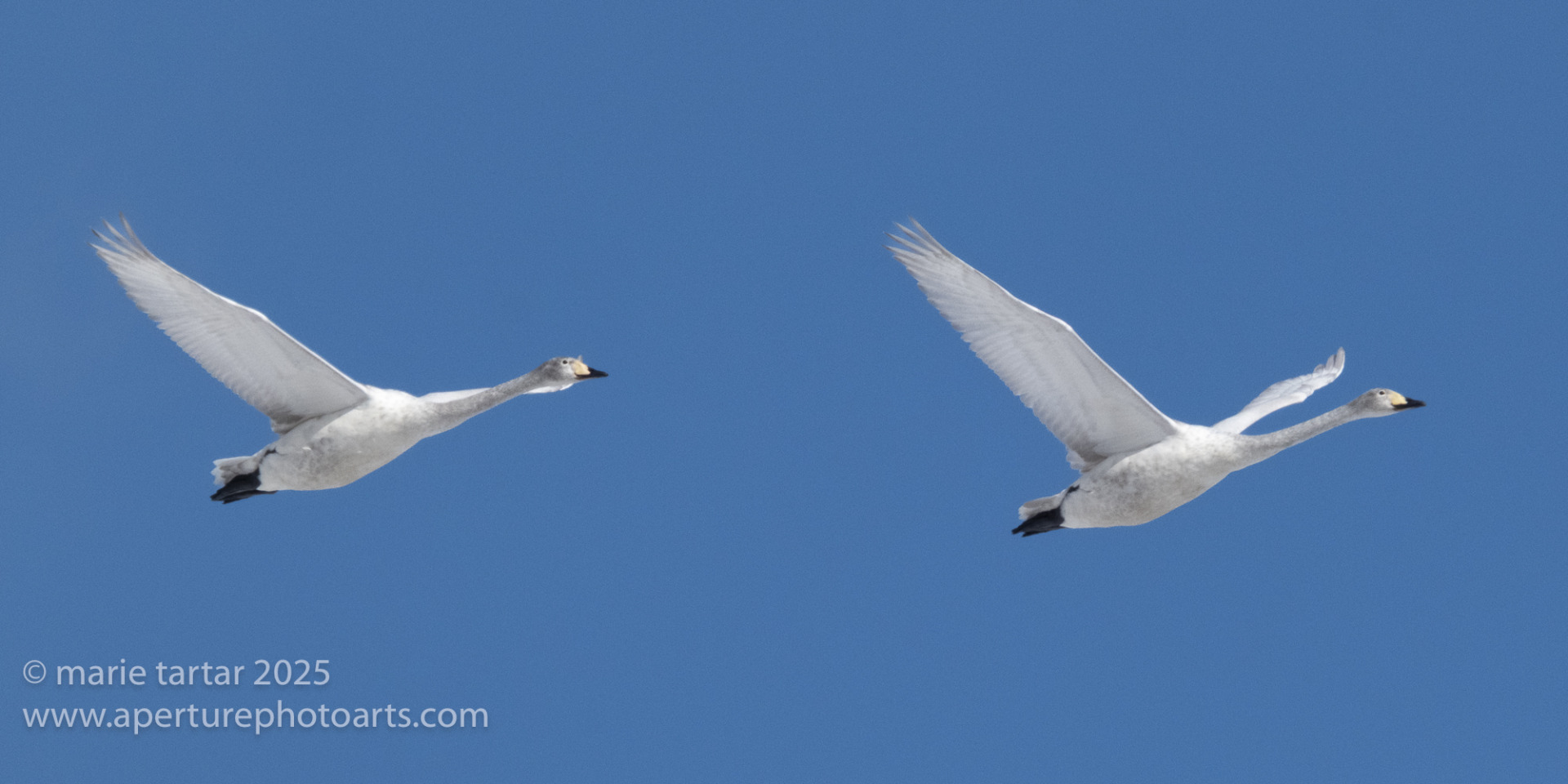
Whooper swans overhead in Hokkaido, Japan and time for us to fly away too, with cards full of images and heads full of memories.
Adventures of a different sort awaited us in Iceland…the write-up is in progress and hopefully will be completed before our next trip to Iceland, planned for the solar eclipse of August 2026.
-Marie

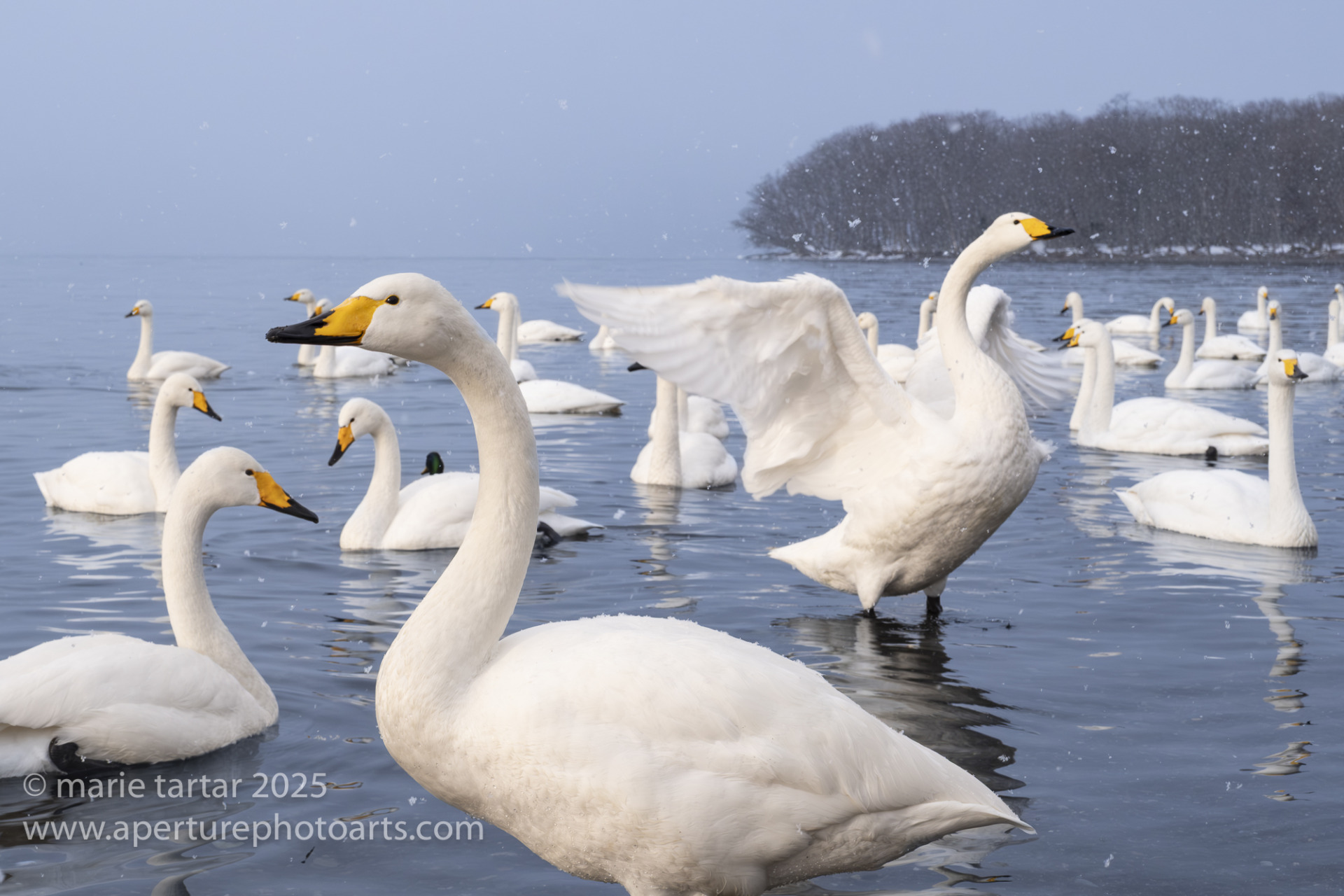
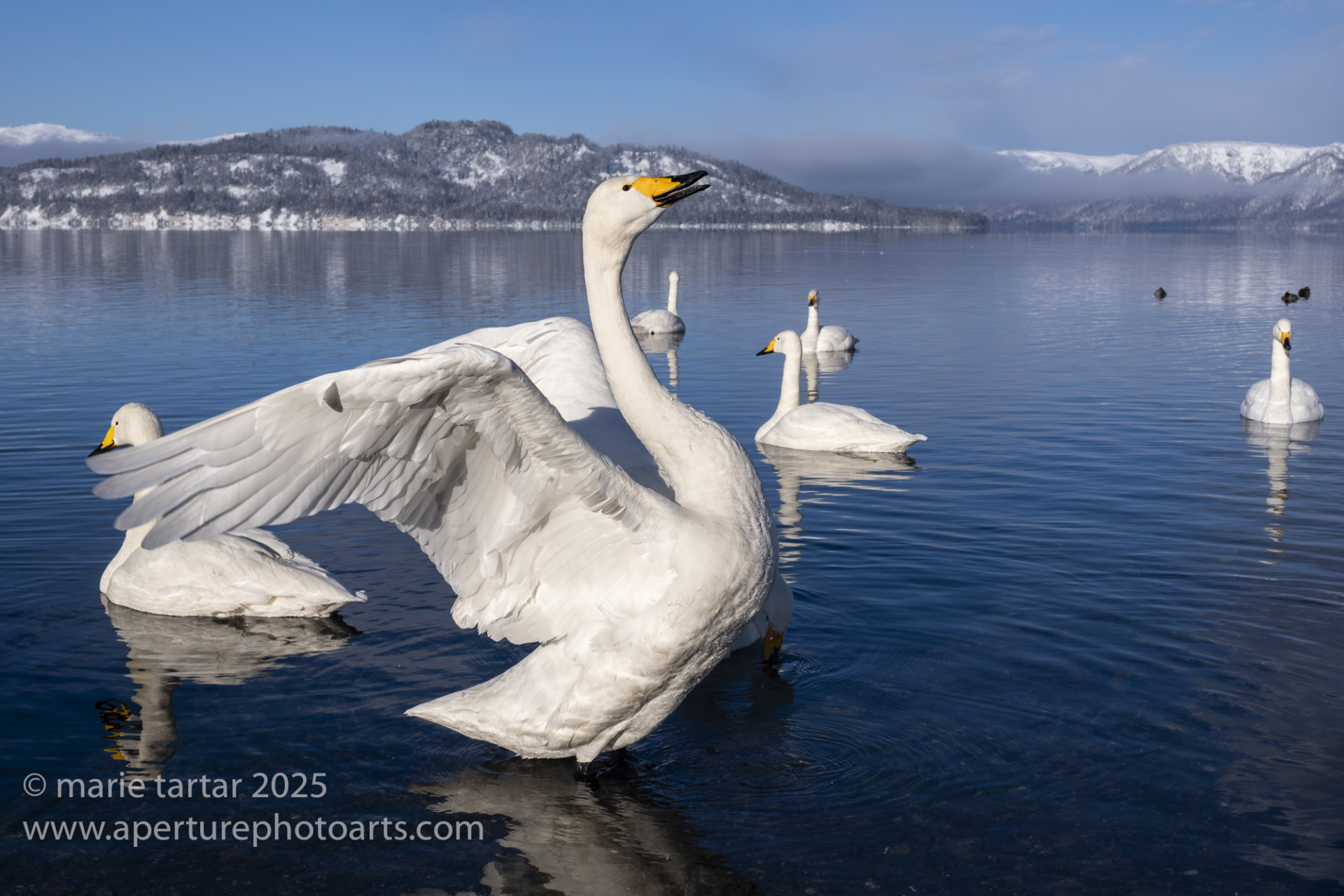
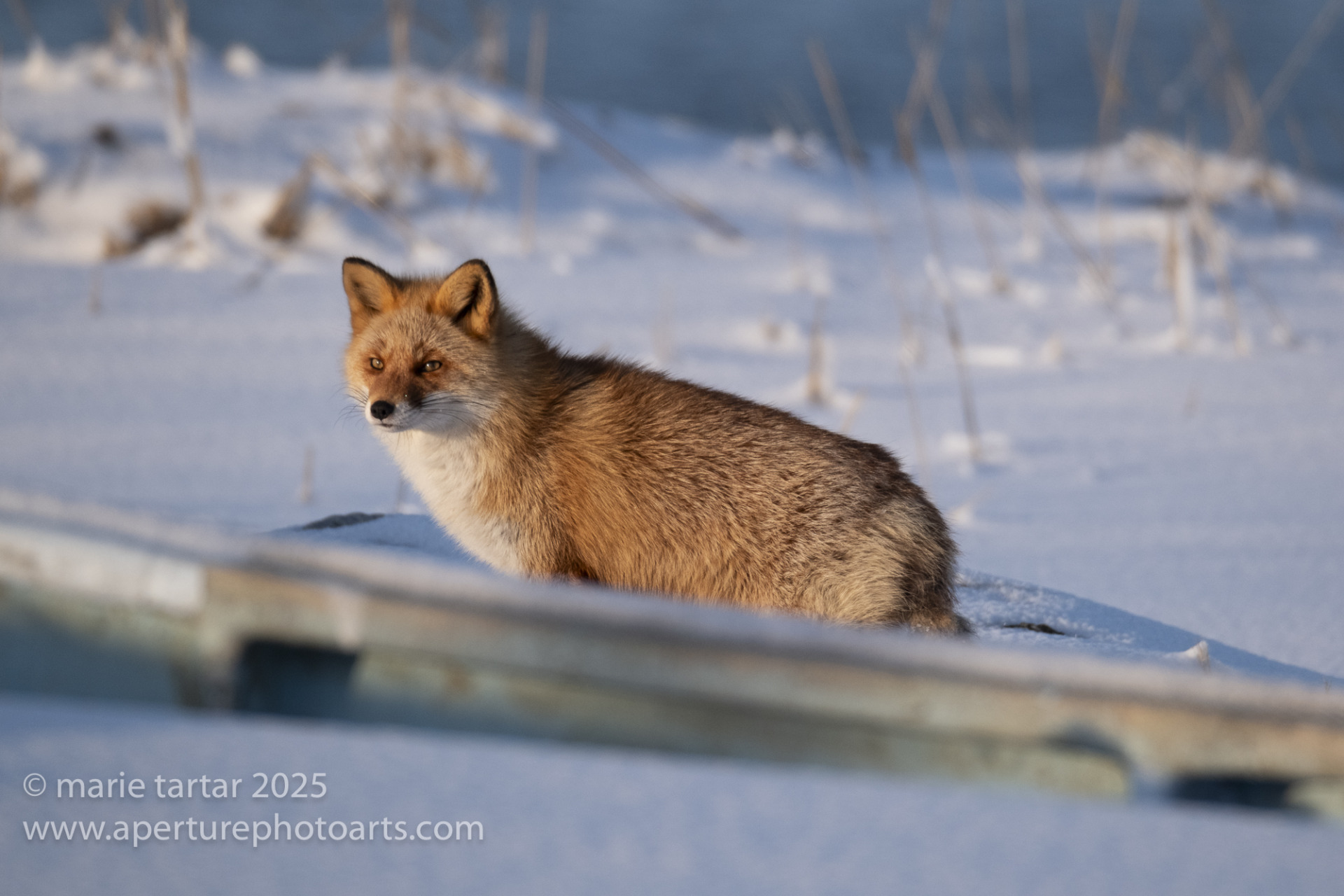
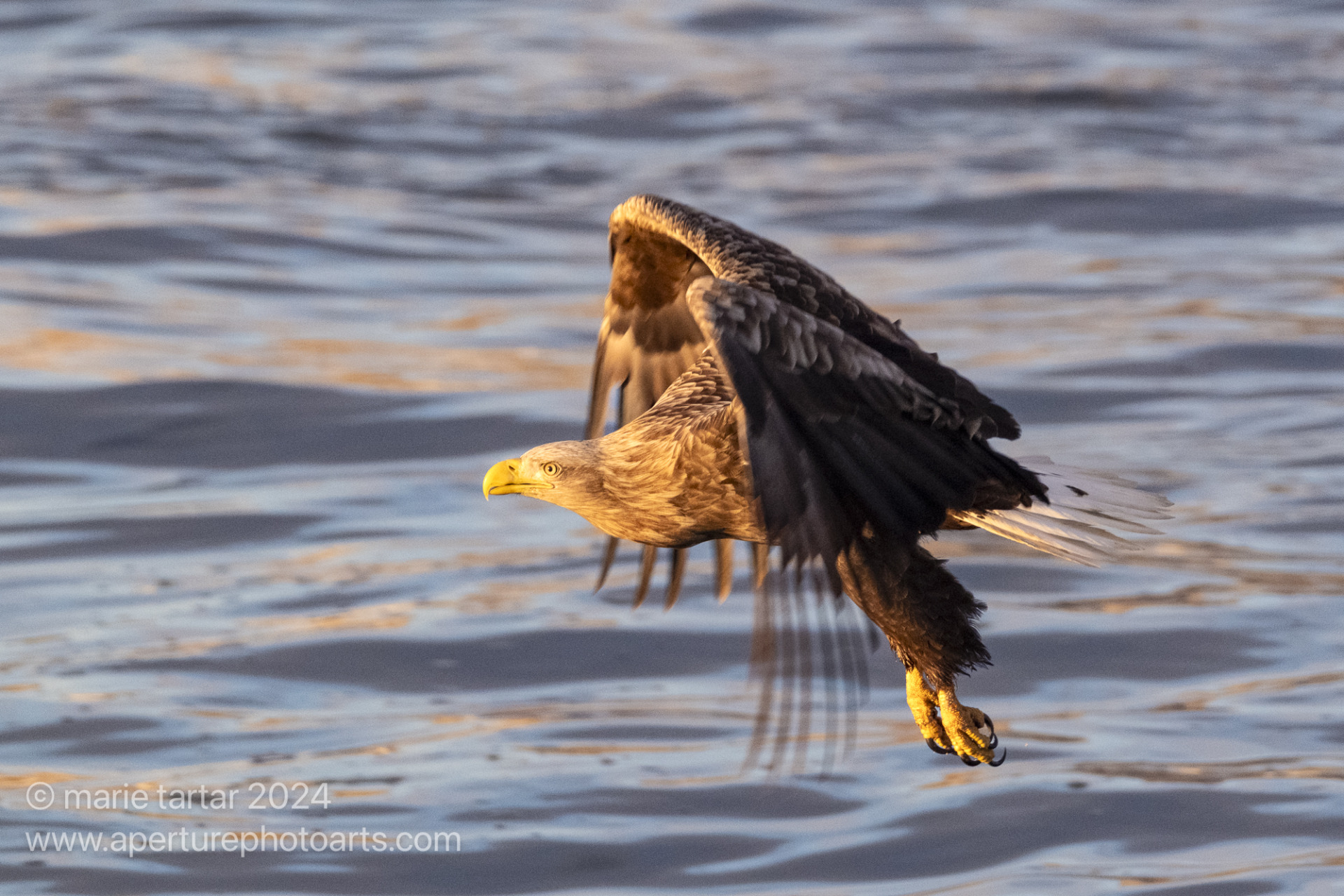
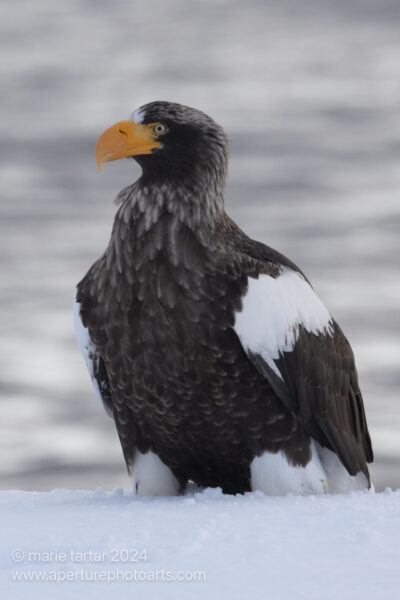
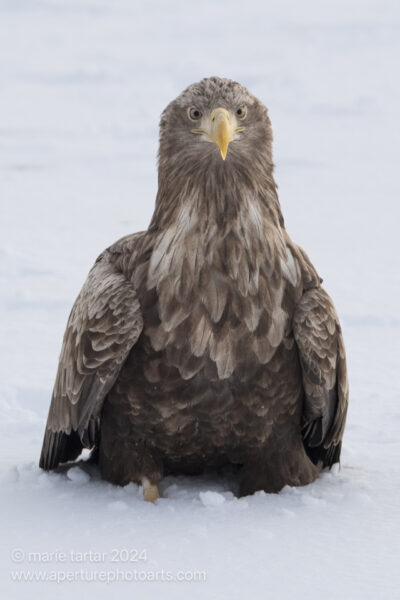
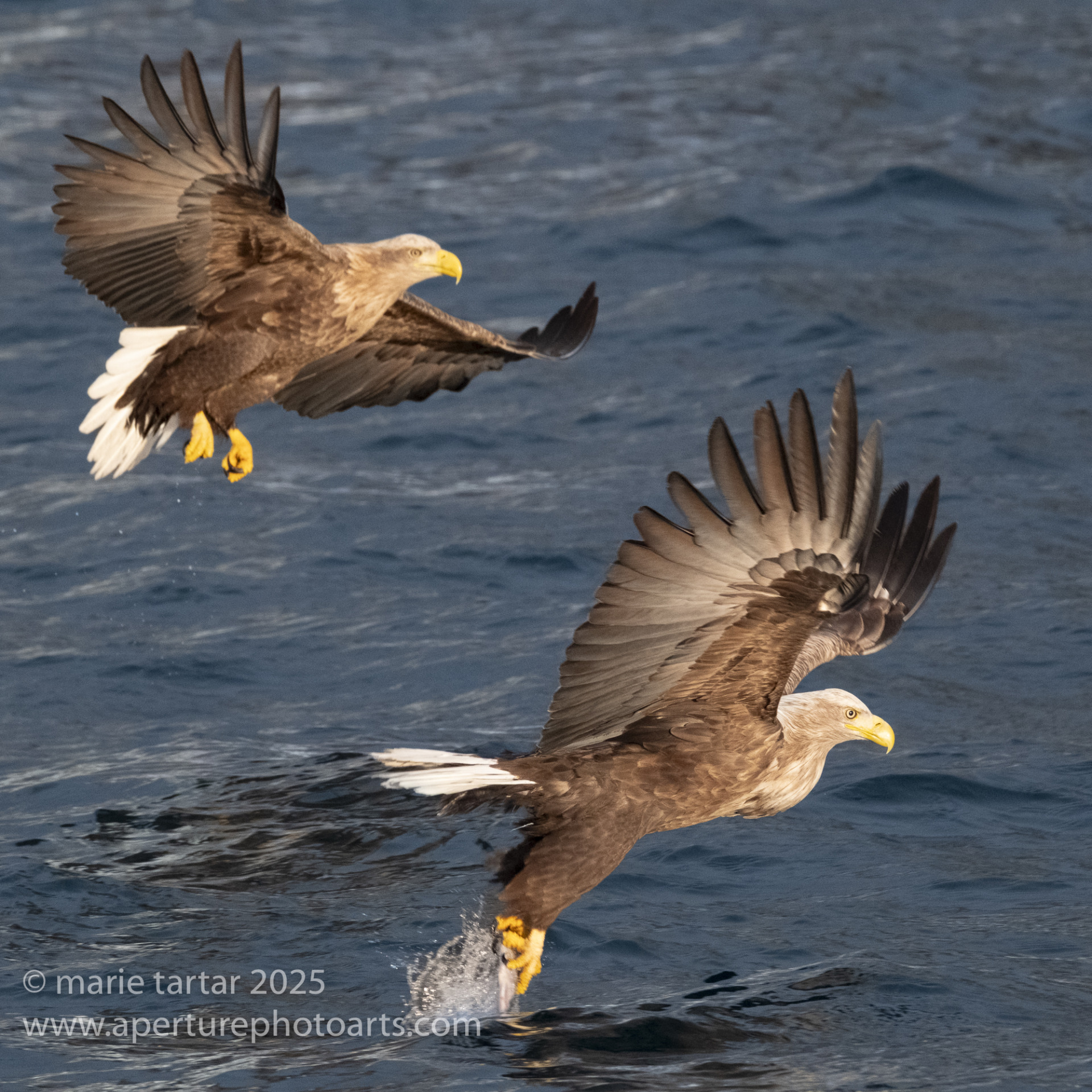
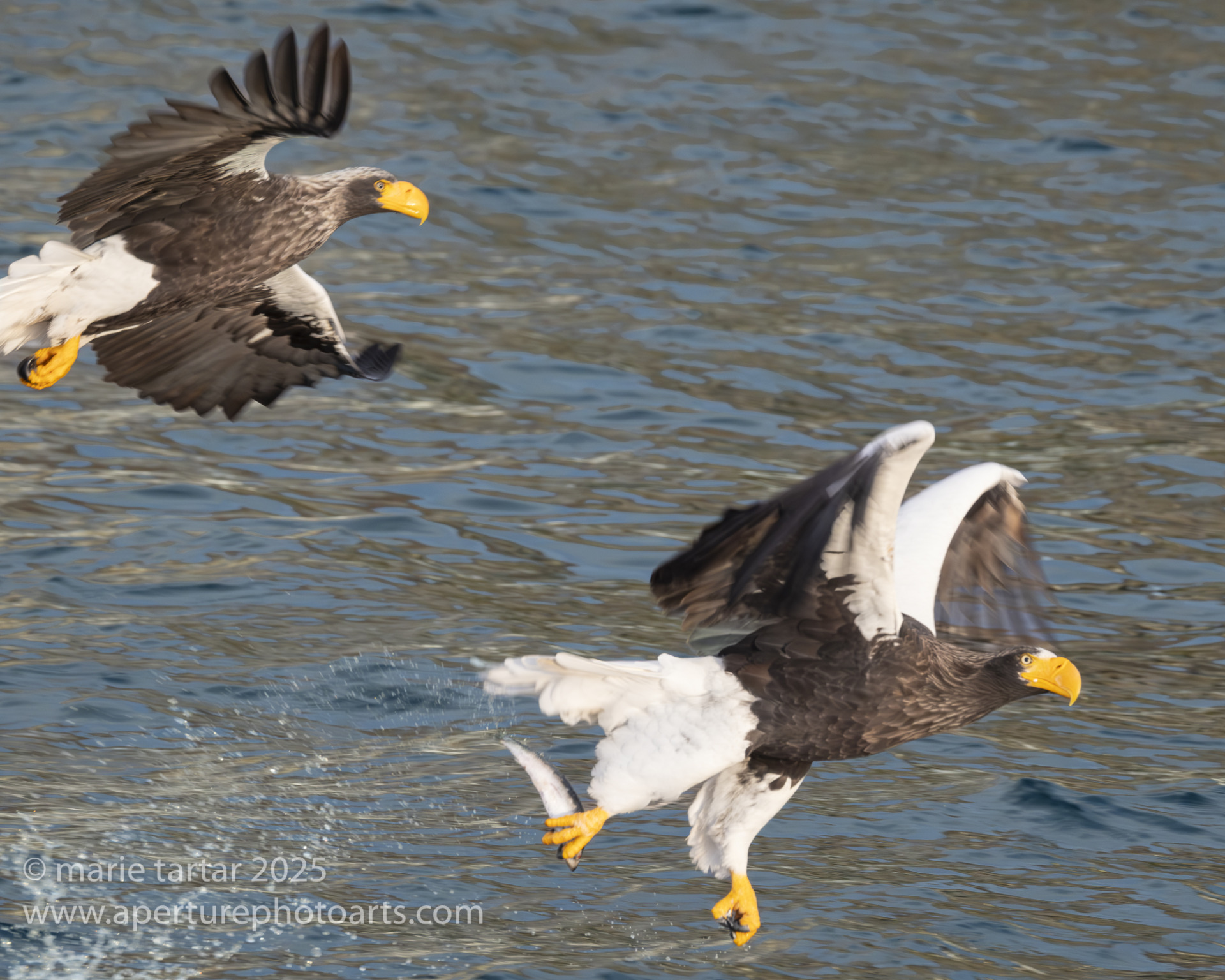
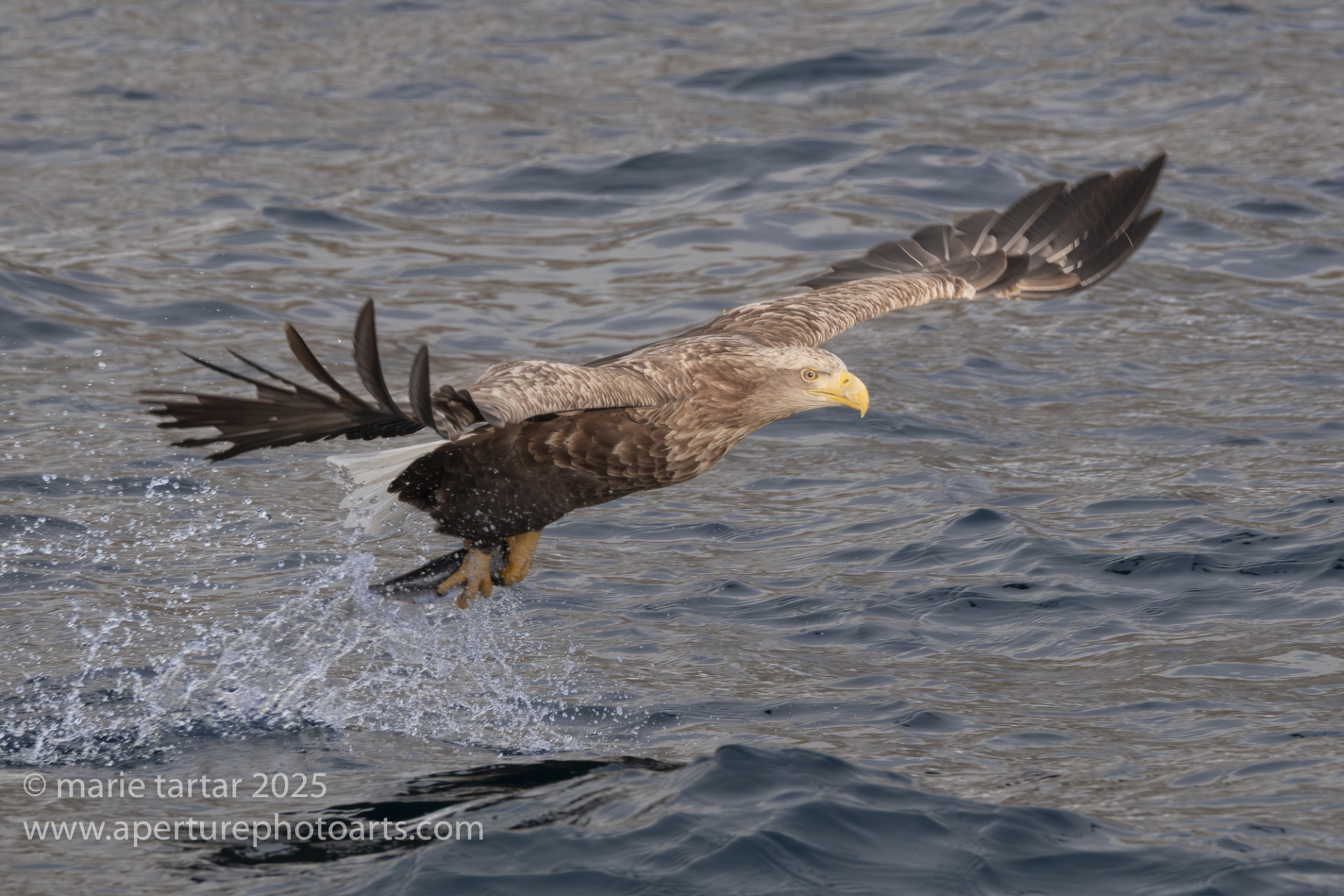
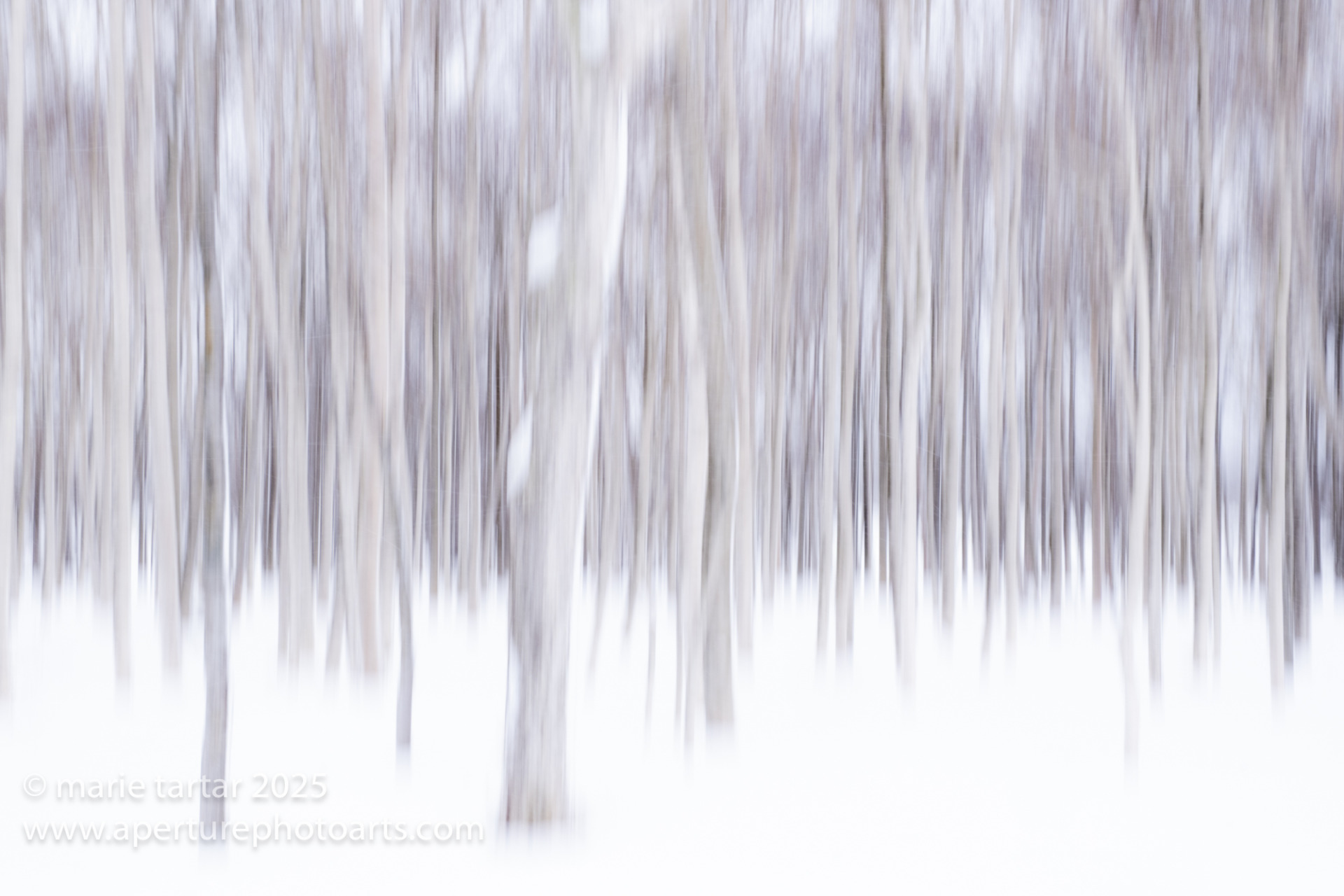
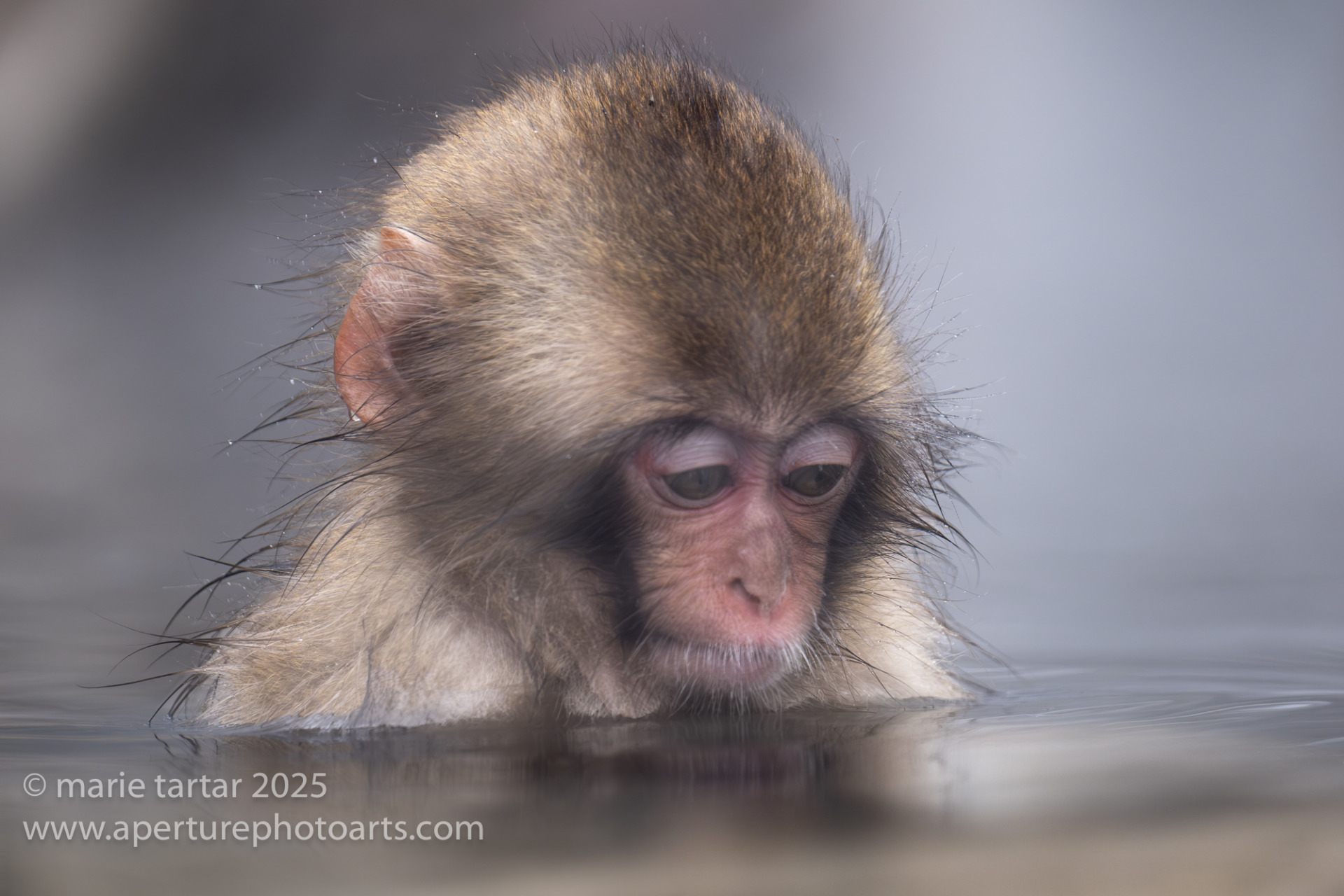

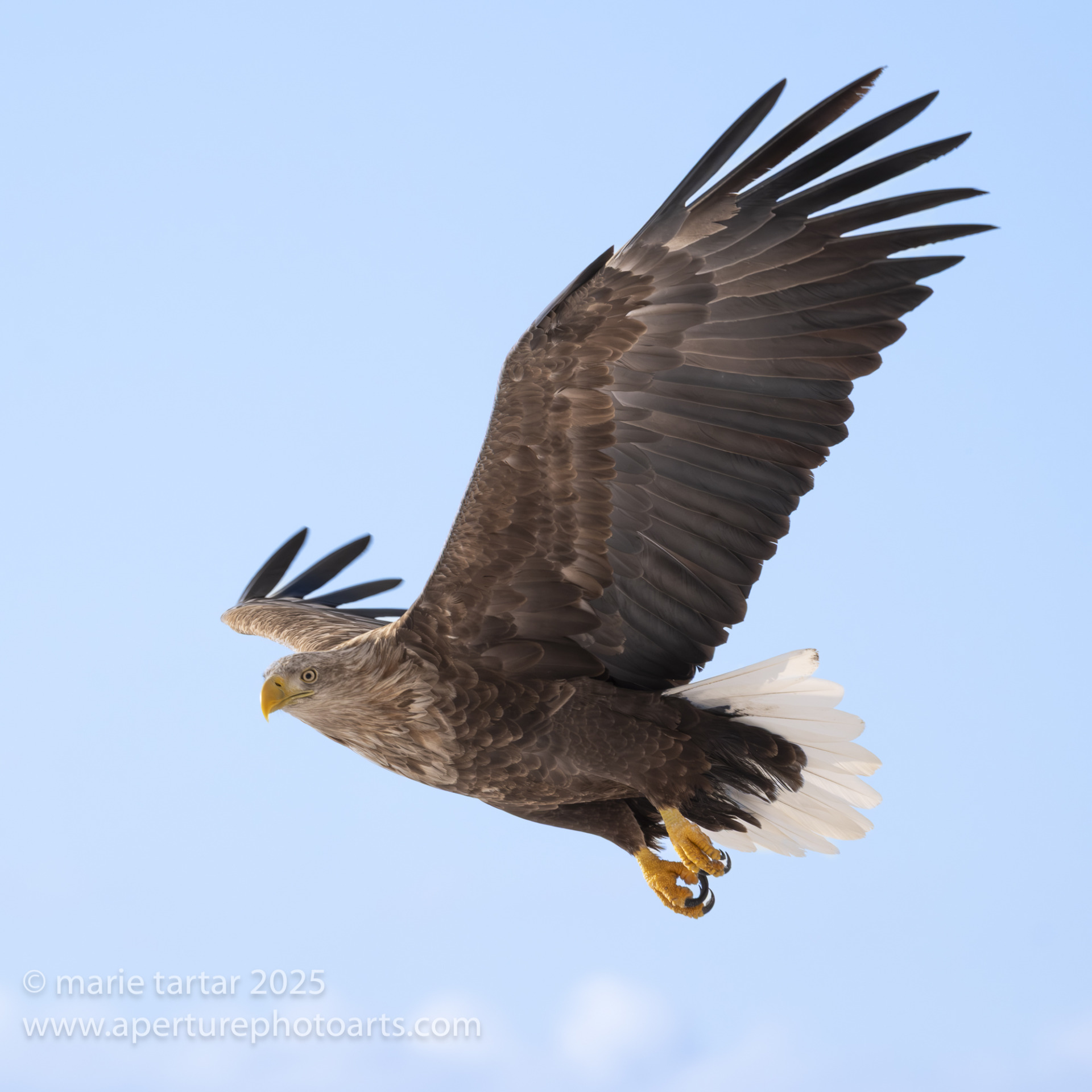
great post , thank you for sharing.